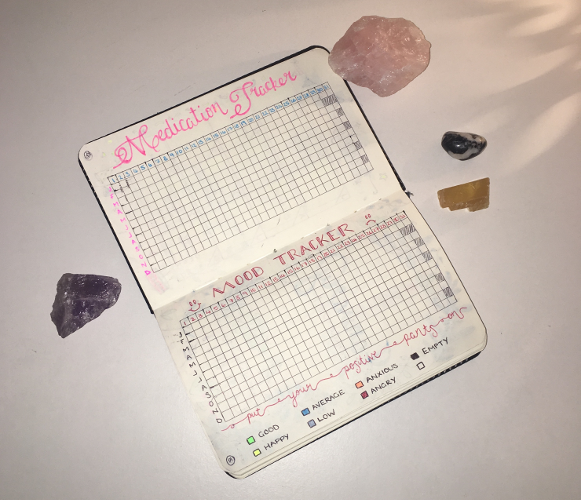It might not be a new concept, but it’s certainly a new craze for me. The Bullet Journal is a simple and adaptable organisation system that provides a totally personal experience. It is your planner, to-do list and more, all rolled into one. Bullet journaling has become a key part of my business activity, and I’ve decided to share how it all works.

If you’re anything like me, you’ve probably got scraps of paper all over the place, covered with lists, scribbles and your next big idea. My desk was covered, along with planners, notebooks and anything else you can think of. But since I started my bullet journal, I’ve felt so much more organised. Plus, it was the perfect excuse for a stationery haul.
Getting Started
You can start bullet journaling with very little cost involved. As long as you have a notebook and a pen, you can have a bullet journal. I use a hardback, plain paper notebook, that’s a little smaller than A5 size. I also have a collection of fine liners, gel pens and highlighters that I use to create my spreads.
There is a simple system that most people use when bullet journaling. This was designed by the bullet journal creator, Ryder Carroll, and works as follows:
• Task – something that needs to be done
X Complete – something that you’ve finished
> Migrated – something you’ve moved, to be completed at a later date
< Scheduled – something you’ve scheduled for a specific date
O Events – a date-related event
– Notes
Before You Get Creative..
There are just a couple of boring things you need to get out of the way. First of all, if the pages in your new bullet journal aren’t numbered, you’re going to need to do that. I numbered all of mine and it took forever – okay, it took a few minutes, but it seemed like forever.
Once you’ve finished numbering your pages, you need to set up your Index. This is going to save you a lot of unnecessary time and page-flipping. You’ll just take a look at your Index and you’ll know exactly what page each item is on. I’ve drawn out a table for mine, but you can set yours up however you like.
Your Basic BuJo Pages
Let’s just address that new word I threw in there: BuJo. I’m pretty sure that’s what you call a bullet journal if you’re down with the kids..
Future Log
This is essentially an overview of the year. My future log is set out across four pages, with three months on each one. This is where you can make a note of any future appointments or notes for spreads that you haven’t created yet. It’s also a simple way to see what you’ve got coming up, at a glance.
Monthly Spread
This is another ‘at a glance’ page, which allows you to see the upcoming month on one page. You can set this out as a list, draw out a calendar, or use a whole different concept. It all comes down to what works best for you. Perhaps you can try a different idea for each month, to help you work out which is your favourite.
Weekly Spread
I personally don’t use weeklies, but I know that a lot of people find them very useful. It’s a similar concept to the monthly spread, but allows you to plan out the next seven days in detail. You can include appointments, tasks, goals and daily habits.
Daily Spread
The daily spread is the part of a bullet journal that eliminates the odd scraps of paper. This is where you can keep track of your to-do lists, notes for each day and anything else you want to keep track of. Daily bullet journaling also gives you the space to keep a log of your diet, water intake, exercise, hours of sleep and so much more.
More Collections
There’s really no limit to what you can use your bullet journal for. I love an old fashioned pen and paper list, and my bullet journal has put a creative spin on that. I use it to track everything that can be tracked. And I love coming up with new design ideas for each spread and tracker.
There’s no way you can cover absolutely everything in one place, but a bullet journal can be your new best friend once you get into the swing of things. I’ve tried several planners in the past, but I was never able to find one that included everything I wanted. I never thought to make my own before I saw a photo on Instagram that intrigued me.

My Medication and Mood Trackers
I’ve had a lot of trouble, in the past, staying on top of my medication. I’ve managed to get myself into a pretty good routine, where I take it after breakfast. Some days, this just doesn’t pan out, so my tracker is a great way of reminding myself whether I’ve taken it on a certain day.
If you have something you need to do on a regular basis, but often find yourself forgetting, a tracker in your bullet journal is a great way to stay on top of it.

Page & Collection Ideas
| Year to View | Birthdays | Dates to Remember | Brain Dump |
| Gratitude Log | Affirmations | Vision Board | Habit Tracker |
| Medication Tracker | Exercise Tracker | Mood Tracker | Energy Tracker |
| Dream Log | Blogs to Follow | Useful Websites | Books to Read |
| TV Shows to Watch | Wish List | Blog Post Ideas | Email Marketing Ideas |
| Future Projects | Launch Planner | Savings Tracker | Budgeting |
| Self-Care | Bucket List | Social Media Calendar | Recipes to Try |
